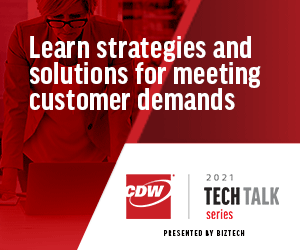Technology trends were largely dictated by the pandemic in the first half of 2021, with many organizations facing the consequences of an upswing in remote work.
Many of the challenges resulting from this trend were common across industries. Remote workers required new equipment, which was sometimes unavailable due to supply chain disruption. And with a distributed workforce, data has been shared across multiple locations and various endpoints, leaving companies vulnerable to cyberattacks.
Team collaboration demanded innovative technology solutions because teams were no longer located in the same workspace. Adjusting to remote work has proved challenging both technologically and psychologically for many employees.
Now faced with a potential return to the office, employers are faced with new security concerns and health and safety issues that must be addressed.
All these issues were discussed in this week’s CDW Tech Talk webcast, which reviewed the predominant IT trends for the first half of 2021 and featured excerpts from this year’s webcasts so far.
WATCH THE WEBCAST: Unlock the exclusive Insider video to see highlights from the first half of 2021.
The Pandemic Presented Organizations With Unforeseen IT Challenges
When the pandemic first hit in 2020, one of the industries most immediately affected was healthcare. Emergency rooms and ICUs rapidly filled up, and healthcare professionals found themselves short on protective equipment. Josh Benson, IT manager at North Valley Health Center in Minnesota, explained how technology assisted his organization with its pandemic response.
“We had to figure out how we were going to do something like drive-through testing for COVID, and we did not have a way to do that. We did have an ambulance drive-through garage, and we tried to figure out how we were going to retrofit it to do testing,” Benson said.
Quinn Chapman, account manager for healthcare at CDW, shared how he was able to assist North Valley in finding technology solutions to meet its needs. Chapman worked with Benson and hospital staff to outfit the garage with connectivity and Ergotron carts. “We did run into one issue at the back end of the project, that being just with the sheer size and weight of the Ergotron equipment, shipping costs were going to be north of $3,000, which was an issue. From there, I actually tapped my counterpart at Ergotron. We were able to pull the equipment out of the Minneapolis-based warehouse and get the all the cards onsite, free of charge,” Chapman said.
MORE FROM BIZTECH: Watch the webcast to hear the full story from North Valley Health Center.
Emmanuel Anderson, director of technology services at Orangetheory Fitness, discovered that the fitness industry also needed innovative technology to solve pandemic-related problems. In a May 4 webcast, Anderson related the experiences Orangetheory had when its members could not work out with trainers in person. They needed to find a way to meet those needs remotely, and CDW was able to help.
“It was really enabling hardware to have a camera with the right quality so you can actually see the coach and almost make you feel like he’s right there with you,” Anderson said. That gave coaches “the ability to leverage technology and hardware to make them feel comfortable that they were still being able to bring value like they do in a studio, but from the comfort of their homes.”
Register below for an upcoming CDW Tech Talk, held Tuesdays at 1 p.m., to hear from IT experts live.
Remote Work Complicated the Storage and Protection of Data
When the pandemic sent people away from their offices for an extended period, companies had to find ways to equip their employees to perform their jobs remotely. A dramatic increase in devices and locations meant that a company’s data was being shared like it never had been before.
In an April 20 webcast, Stephen Manley, CTO at Druva, made note of the shift from on-premises data centers to the cloud. “What we’ve seen is that the data center is no longer the center for all the data. One of the key things I think to realize in this is that I don’t think people adopted it because they said, ‘I want my data in different places.’ It’s always the apps that drive us, so you saw this this big surge toward SaaS applications.”
“When we started talking endpoints, that leads you to the edge, and that’s really where I think you’re going to see a lot of growth in the next couple of years. Data has really become sprawled all over the place, not because people said, ‘I want my data sprawled all over the place,” but because they said, ‘I’m running applications, and that’s where my applications are running,” Manley said.
With data spread out, the need to protect that data became a priority. In a March 2 webcast, Gabe Whalen, principal field solution architect at CDW, spoke about the individual employee’s role in maintaining data security.
“I think fundamentally, security relies on everyone in your team, whether it’s a second party, third party or your employee responding when they see something happening,” Whalen said. “There’s nothing quite as demoralizing as when an employee does do the appropriate thing and it falls on deaf ears, or it doesn’t go anywhere. Then we start learning about shadow security and the effectiveness of an organization. I think responding to those employee concerns in a quick manner and staying transparent helps keep that level of interest across the organization.”
HEAR MORE: Check out the full March 2 webcast to learn more about employees' role in security.
The Workplace Has Changed Significantly, and Perhaps Permanently
Now that business leaders are considering a return to the office, even one that includes some element of remote work, those workspaces must change to address new needs and concerns.
Stephen Miller, brand ambassador at Lenovo, spoke March 16 about the changing needs of a distributed workforce. According to Miller, some companies will need less real estate than they did prior to the pandemic. And many companies will choose to remodel their spaces.
“Headquarters should become collaboration centers,” he said. “Why rows of cubes? Why not areas where I can huddle, and I come in because I want to see my team and we really need to be together — not a space like Cube World. We need a space where nine of us can huddle with the others, knock this out in person, and then commute at 1 p.m., not at 4 p.m. in rush hour. Headquarters needs to evolve into a collaboration center.”
Social Unrest Spotlighted the Need for Ethical Technology
The pandemic wasn’t the only major event that affected IT and business decisions over the past year. Social unrest and calls for equity and inclusion have been heard by members of the C-suite, and they’re looking to technology for help in answering those calls.
Kristin Malek, director of business diversity at CDW, joined us for a webcast on April 6 to talk about diversity. “There is a real-time demand in our country and beyond for equity in the workplace, in the workforce and in our new digitized supply chain. I think it’s fair to say that the temperature in our country perhaps has never been hotter as it relates to economic mobility and economic empowerment. So, at CDW, we are constantly looking to create a solution to this desired equity in the supply chain and in all pillars of our business, and it is through impactful sourcing,” she said.
“What are we tracking?” Malek asked. “It’s much more than spend. You know we are never going to spend our way to justice. What I believe is that we can move from just sourcing and procurement to impactful sourcing and intentional procurement, because instead of tracking dollars spent, we need to be tracking the lives that we’re enriching.”
MORE FROM BIZTECH: Check out the original webcast in its entirety to learn more about ethical technology.
Employers Will Need to Accommodate New Expectations This Year
Ben Weiss and Tom Cahill, both of CDW’s product and partner management team, joined the conversation to share their thoughts on what to expect from the rest of 2021.
Cahill pointed out the altered expectations of employees who have been working from home with elevated levels of flexibility. “I think what’s happened now is the flexibility and the quality that we have from the standpoint of working at home, there is a demand now as we go back to the office of, ‘I want that flexibility and I want that same quality,’” he said.
“Now it’s about that collaboration experience. It’s about mobility, it’s about comfort, and we’ve all developed this sort of experience at home. So, as we think about folks going back into the office, we’re working with customers to ensure that that transition is seamless,” Cahill continued.
Weiss agreed, saying, “As you think about going back to the office, first and foremost, you’re going to have to duplicate that environment. You’re going to have to produce an environment where a coworker feels like they have everything they need to collaborate, whether it be with other folks in the office or people working remotely.”
Follow BizTech’s full coverage of the CDW Tech Talk series here. Insiders can register for the event series here.













